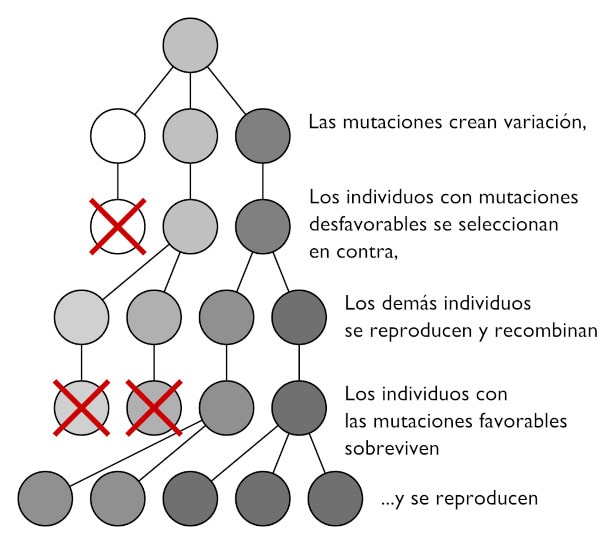
Natural selection is the phenomenon by which some favorable mutations help different organisms survive longer than others without them, granting them evolutionary advantages and thus more chances of survival and passing on those genes.
This concept is often used to talk about the success of certain sectors, companies, or products, though there are differences. The key is in the adjective natural. While evolution doesn’t have conscious influences, the economy is full of management mechanisms. But what does this have to do with the color of industrial machinery?
What is natural selection?
Natural selection is an evolutionary process by which less fit individuals do not transmit their genes to the following generations by not reproducing before dying, and vice versa: better-adapted individuals do manage to do so, giving rise to the phenomenon of unintentional selection.
While natural selection is now known not to be the only cause of evolution, it undoubtedly plays a fundamental role in selecting (involuntarily) certain genetic lines over others due to reproductive success. The most adapted have more offspring. But how can this be applied to engineering?

Aptitude and evolution through selection
In the modern theory of natural selection, the concept of aptitude is crucial, hence the phrase survival of the fittest. Of course, this applies to entire species, not just individuals, and statistics comes into the picture. If one species has a fertility rate of 3 and another of 2.5, the former displaces the latter.
As the fittest species multiply, it is more likely that mutations leading to new species in the future will emerge. For example, humanity has long obeyed not natural selection but human selection, which can be applied to our domesticated animals.

Our current bovine varieties have been modified by humankind over millennia.
A brief history of natural selection
The first time the concept of biological evolution was described by natural selection was in Charles Darwin’s renowned The Origin of Species (1859), where he discusses this topic. However, his work was built on that of previous authors.
- Carl Linnaeus (1707-1778) noticed that species seemed to share a family tree.
- Georges Louis Leclerc, Comte de Buffon (1707-1788), understood evolution the other way around: chimpanzees were thought to be ‘degenerate’ humans.
- Georges Cuvier (1769-1832) invented comparative anatomy and pointed out that there were cataclysmic events and great extinctions in the past.
- Lyell (1797-1875) was right when he said that there were cycles of species destruction and creation.
- Jean-Baptiste de Monet, Chevalier de Lamarck (1744-1829), was wrong about the evolutionary mechanism (really wrong), but he correctly deduced that there were causative forces behind the evolutionary tree.
What natural selection is not
It is often said that natural selection entails the “survival of the fittest,” though this is often misunderstood. This doesn’t refer to the strongest species. “Fittest” is not necessarily the strongest, the fastest, or the smartest, but the best adapted. For example, the species that can best resist a disease or the one that multiplies the fastest can survive.
Another common mistake is confusing natural selection with Lamarckism, a theory that was never proven. It suggested that genetic traits were changed by environmental exposure and then passed on to subsequent generations. Biological evolution doesn’t work this way – but artificial evolution does through prototyping: the variations made in one model can jump to the next.
Natural selection is sometimes used to explain market trends, though this is not appropriate. The attribute natural implies a lack of voluntariness or interference (e.g., social norms, laws, or regulations), as occurs in natural experiments which arise arbitrarily and unintentionally. Human beings have voided out the mechanism of natural selection for our species because we intervene in the possibilities of gene transmission.
Technological convergence and Darwinian mechanisms

Despite this, Darwinian dynamics are often used to explain certain technological adoptions. For example, there are no ball-shaped pens because that would be such an inefficient shape that isn’t suitable to hold. We don’t see square wheels, either. It’s not that they aren’t possible, they’re just not effective. If a company makes them, they probably won’t last too long before going out of business.
Another example is the color of industrial machinery. Why is it always yellow or red? One possible explanation is that color may have impacted safety. After all, it’s easier to see a yellow forklift than a brown one. Companies that used other colors slowly died out, so to speak.
If we continue along that line, companies that work with better steel, better types of concrete, and qualities that are demonstrably more adapted in general will have more opportunities for the future. To some extent, it’s a Darwinian mechanism.
Is path dependence a kind of evolution?
Often, the properties of an object are inherited from the previous generation of that object, often a simpler version; in other cases, properties of several elements are combined to give rise to a new one.
- Technological inertia is the path that technology follows due to the existence of previous technology. For example, phone keyboards resemble the physical computer keyboard, which in turn, is a version of the typewriter.
- Technological emergence is the manifestation of a new property due to the combination of simpler elements. For example, cell phones combine a screen, a camera, and sensors, among other things.
Technological evolution often follows Darwinian mechanisms in the appearance of new objects and the extinction of the previous ones. Nowadays, almost no one uses typewriters or listens to cassette tapes.
Main image: Eugene Zhyvchik,





There are no comments yet